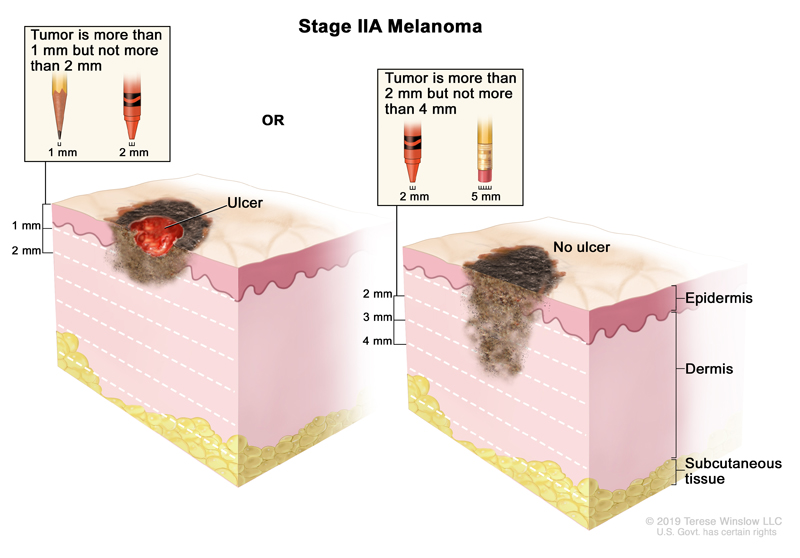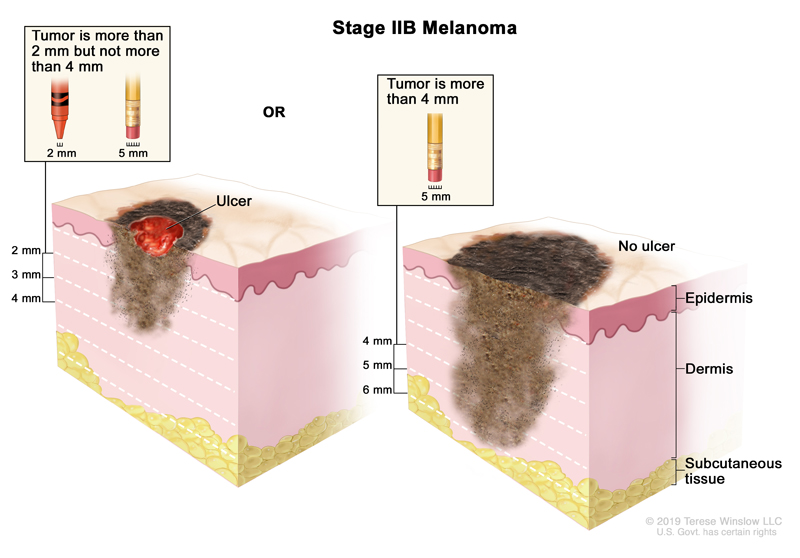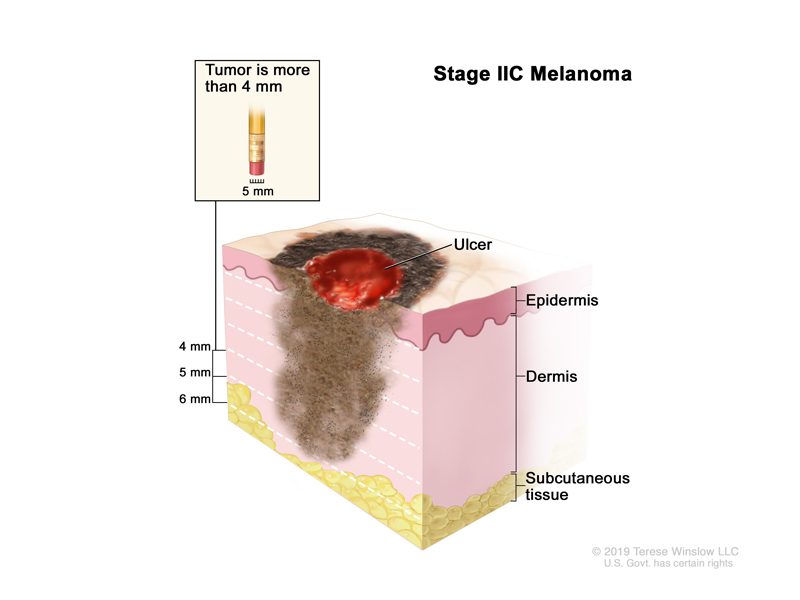Stage 2 Melanoma is divided into Stage 2A, Stage 2B and Stage 2C. The sub-stage depends upon the cancer’s depth and the amount of breakdown of your skin (ulcers).
Understanding your Stage 2 Melanoma diagnosis will help you partner with your doctors to make the best treatment choice for you.
Stage 2 Melanoma Cancer ICD 10 is C43.59.
Tap “Watch Now” for an easy-to-understand overview of Stage 2 Melanoma.
- Stage 2A Melanoma
- Stage 2B Melanoma
- Stage 2C Melanoma
Overview
Stage 2A Melanoma affects the skin only and has not spread to lymph nodes or other organs.
It shows itself in one of 2 ways in your body:
1. The tumor is 1.0-2.0 millimeters deep with a breakdown of your skin, called an ulcer, as shown in the left image
or
2. The tumor is 2.0-4.0 millimeters deep without an ulcer, without affecting lymph nodes or any other organs in your body, as shown here on the right of the image.
What Tests Will I Need and Why?
Blood and Imaging tests are done to understand your general health, confirm your diagnosis and determine your cancer stage.
Tissue analysis is also typically done to identify the cancer cell type, which is critical to finding the best treatment option for you.
If your treatment team has not already performed tests to determine your cancer’s features, please ask your doctor when these tests will be performed.
Re-read this summary as needed and then tap, “Compare My Treatment Options Now“. Our unique Comparison Page will help you understand your FDA-approved treatment options including, who can help you pay for your treatment, where and how each is given and what side-effects you may experience.

National Institute of Health/ treatment-melanoma
Overview
Stage 2B Melanoma affects the skin only and has not spread to lymph nodes or other organs.
It shows itself in one of 2 ways in your body:
1. The tumor is 2 to 4 millimeters deep with a breakdown of your skin, called an ulcer as shown on the left
or
2. The tumor is more than 4 millimeters deep without an ulcer, without affecting lymph nodes or other organs in your body, as shown on the right.
What Tests Will I Need and Why?
Blood and Imaging tests are done to understand your general health, confirm your diagnosis and determine your cancer stage.
Tissue analysis is also typically done to identify the cancer cell type, which is critical to finding the best treatment option for you.
If your treatment team has not already performed tests to determine your cancer’s features, please ask your doctor when these tests will be performed.
Re-read this summary as needed and then tap, “Compare My Treatment Options Now“. Our unique Comparison Page will help you understand your FDA-approved treatment options including, who can help you pay for your treatment, where and how each is given and what side-effects you may experience.

National Institute of Health/ treatment-melanoma
Overview
A Stage 2C Melanoma diagnosis is when the cancer is more than 4 millimeters deep with an ulcer, as shown here. As you can see, the cancer is just above the Subcutaneous tissue layer of your skin, shown here in yellow.
In Stage 2C Melanoma, the cancer has not affected your lymph nodes or any other organs in your body.
What Tests Will I Need and Why?
Blood and Imaging tests are done to understand your general health, confirm your diagnosis and determine your cancer stage.
Tissue analysis is also typically done to identify the cancer cell type, which is critical to finding the best treatment option for you.
If your treatment team has not already performed tests to determine your cancer’s features, please ask your doctor when these tests will be performed.
Re-read this summary as needed and then tap, “Compare My Treatment Options Now“. Our unique Comparison Page will help you understand your FDA-approved treatment options including, who can help you pay for your treatment, where and how each is given and what side-effects you may experience.

National Institute of Health/ treatment-melanoma
Recommended Melanoma Cancer Videos

Understanding Melanoma
Causes, Staging & More

What Are The Stages of Melanoma?
Melanoma expert Jeffrey Weber, MD, PhD,

How Cancer Spreads
Metastastis

Diagnosing Your Cancer
How Does a CT Scan Work?

Diagnosing Your Cancer
How Does a PET Scan Work?

Exercise! You Can Do It
Reducing Side Effects & More
Commonly Searched Questions
Stage 2 Melanoma Treatment
Surgery is the best treatment option for Stage 2 Melanoma. Some doctors may recommend doing a sentinel node biopsy as well.
Source: Cancer.org
Stage 2 Melanoma Definition
Stage 2 melanoma is defined as a stage where the melanoma is more advanced but still confined to the skin. At this stage, the cancer is characterized by its thickness and the presence of ulceration. Specifically:
- Stage 2A: The melanoma is more than 1.0 millimeter thick but less than 2.0 millimeters thick, and it may or may not be ulcerated (has an open sore).
- Stage 2B: The melanoma is between 2.0 and 4.0 millimeters thick and is either ulcerated or non-ulcerated.
- Stage 2C: The melanoma is more than 4.0 millimeters thick and is ulcerated.
Stage 2 melanoma indicates that the cancer has not spread to the lymph nodes or other parts of the body, but it is more likely to recur compared to earlier stages.
Source: Cancer.org
Stage 2 Melanoma Survival Rate
The five-year survival rate for stage 2 melanoma is 99.5%. That means 99.5% of people diagnosed with the disease are alive five years later.
Source: Cancer.gov
Stage 2 Melanoma Symptoms
Look for anything new, changing, or unusual on your skin, especially new moles. The ABCDE can help you detect Melanoma.
- A for asymmetry
- B for borders (uneven)
- C for color (multiple colors in one mole)
- D for diameter (larger than 6mm)
- E for evolving (size, shape, color, elevation of a spot on your skin)
Source: Skincancer.org
Stage 2 Melanoma Recurrence Rate
The overall prognosis for stage 2 melanoma shows an excellent outcome of 99.5% for the 5-year survival rate, but 13-20% of the patients still experience recurrence.
Source: PubMed.gov
Stage 2 Melanoma Prevention
While specific prevention strategies for Stage 2 Melanoma, where the cancer has spread deeper into the skin but not to lymph nodes or other organs, are not provided, general preventive measures to reduce the risk of melanoma include:
- Avoid Excessive Sun Exposure: Limit direct sun exposure, especially during peak hours (10 a.m. to 4 p.m.), and seek shade when possible.
- Use Sunscreen: Apply a broad-spectrum sunscreen with an SPF of 30 or higher on all exposed skin. Reapply every two hours and after swimming or sweating.
- Wear Protective Clothing: Use hats, sunglasses, and long-sleeved clothing to protect your skin from UV rays.
- Perform Regular Skin Checks: Conduct monthly self-exams to monitor your skin for new or changing moles or spots, noting any changes in size, shape, or color.
- See a Dermatologist: Have regular skin examinations by a dermatologist, especially if you have a family history of melanoma, multiple moles, or a history of severe sunburns.
Avoid Tanning Beds: Do not use tanning beds or other artificial sources of UV light, which can increase melanoma risk.
Source: PubMed.gov





